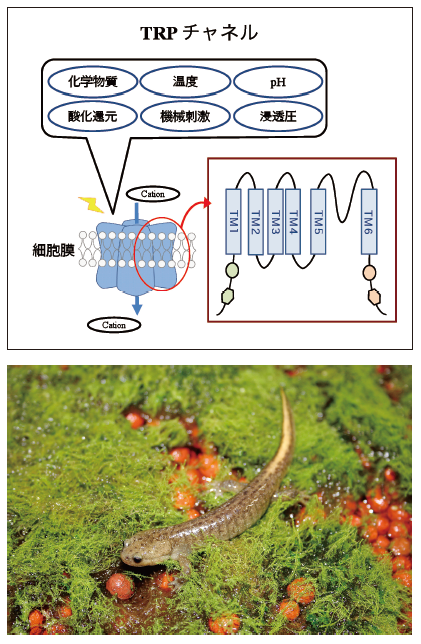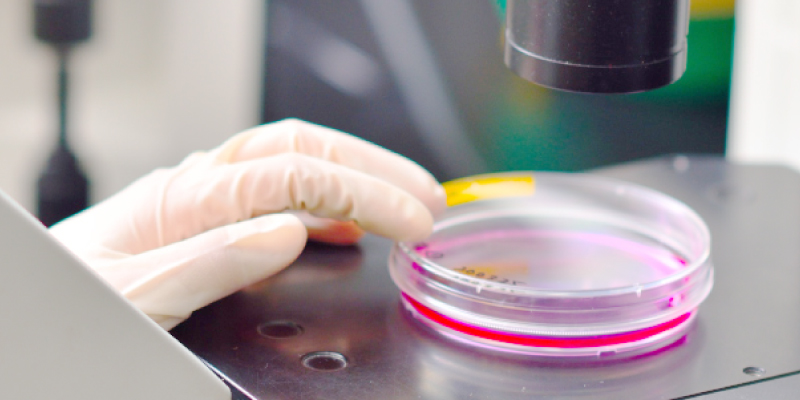アニマルバイオサイエンス学科
 齊藤 修(さいとう・おさむ)
齊藤 修(さいとう・おさむ)
Osamu Saitoh
専門分野/分子生物学、神経生物学、生化学研究キーワード/感覚センサー、野生水生動物
職位:教授
学位:理学博士(東京大学)
- 東京大学大学院理学研究科博士課程修了
- バーモント大学(米国)医学部、国立精神・神経センター神経研究所、東京都神経科学総合研究所の研究員を歴任。
研究テーマ
(1) 動物の多様性及び環境適応を支える感覚センサーの機能

動物は、水中で生まれ進化を経て、陸上へと分布を広げていったと考えられている。しかし、その生存環境の差は非常に大きい。水中は、温度環境が極めて安定しているが、水に溶ける酸素には限りがあり、エネルギー効率が悪い。これに対し、陸上に進出すると、呼吸によるエネルギーの獲得効率は飛躍的に向上するが、一方で温度環境は劇的に変化しやすくなり、日光による急激な温度上昇や乾燥、場合によっては極端な低温と戦わなければならない。しかし、実際には、動物たちは、水中から陸上へ、更に極めて多様な生息環境に適応し、生息域を拡大した。この「環境の変化に適応して陸棲化し、分布拡大していった動物たちは、外界から温度情報・刺激を受け取る感覚の仕組みや感度を大きく機能変化」することが生存戦略上必要であった筈である。
動物が持つ細胞外からの主要な侵害刺激センサーは、Transient Receptor Potential(TRP)チャネルと考えられている。これらTRP チャネルは、近年、浸透圧、機械刺激、化学物質、温度、pHなど多数の刺激によって活性化されることが発見されてきた。その中で、特に感覚神経に発現する主要な温度感受性TRP は、TRPM8、TRPV1、更にTRPA1などである。本研究室では、これらのTRP センサーを中心に、水中に棲む魚類はどんな感受性を持った感覚センサーを持っているのか、動物の陸棲化に伴って感覚センサーの働きがどう変化したのか、多様な生息環境への適応に感覚センサーの変化がどう関わっているのかなどについて、様々な動物からTRP チャネル遺伝子を単離し、解明を進めている。
(2) 滋賀県内に生息する希少水生動物の生息実態調査と遺伝系統の解明
滋賀県には我が国最大の湖で世界有数の古代湖でもある琵琶湖があり、特に大学の位置する湖北地方は、今なお豊かな生物多様性を保ち、早春には希少種カスミサンショウウオの産卵、初夏にはホタルの飛翔や琵琶湖から各河川への魚の遡上を見ることができる。また、一部の北部渓流では、国の特別天然記念物・オオサンショウウオの繁殖が県内で唯一確認されている。これらの豊かな生物多様性を如何に未来に残してゆくかを探る為、特に希少水生動物に注目して、サンショウウオ類・カエル類・希少魚類などの生息状況の実態調査と、DNA 解析による遺伝系統把握を進めている。
| 研究の応用領域 | 産官学連携で求めるパートナー |
|---|---|
| 医薬品・飲食品の開発、環境アセスメント | 医薬品・飲食品開発の関連企業、大学・自治体の研究機関 |
Topics of research
(1) Somatic sensation enables animal body to feel, to ache, to chill, and to know what its part are doing. It is sensitive to many kinds of stimuli. The sensing transduction occurs in nerve endings of sensory neurons. Various noxious stimuli are sensed by membrane proteins mainly including ion channels belonging to the transient receptor potential (TRP) channel family. A main member of the rodent TRP family in sensory neurons, TRPA1, functions as a sensor for cold temperature and also for chemicals such as allyl isothiocyanate, caffeine, oxidized epigallocatechin gallate, acrolein present in wasabi, coffee, green tea, and vehicle exhaust. In recent years, the species-specific differences of TRPA1 functions, however, have been reported. The human and rhesus monkey TRPA1s are not activated by cold and TRPA1s from several tetrapod vertebrates are activated by high temperature. In addition, it has been shown that rodent and human TRPA1s respond differently to chemical ligands. These observations suggested the possibility that nociceptive receptors such as TRPA1 are likely to play important roles in the survival strategy during the course of evolution and environmental adaptation of taxa.
Therefore, to understand the functional evolution of TRPA1 in vertebrates, we first focused on TRPA1s from several fish species. We investigated the functional properties of zebrafish TRPA1 paralogs (zTRPA1a and b) and Takifugu TRPA1. We found that zTRPA1b and Takifugu TRPA1 show statistically significant cold and heat-induced responses. This was the first demonstrating the function of TRPA1 as a dual thermal sensor. Further, we observed that fish TRPA1s were gradually heat-activated over about 25°C with no clear threshold. It has been reported that TRPA1s from several tetrapod vertebrates are activated by high temperature with a clear temperature threshold. Because water has a high heat capacity, water temperature responds less to the addition and extraction of heat energy and is relatively stable compared with temperature on land. Therefore, the gradual heat activation must be one of the specific features of TRPA1 of vertebrates living in water environment.
To further approach the functional evolution of nociceptor, TRPA1 during the land advance of animals, our research project is to characterize the function of TRPA1s from other teleost fishes, lobe-finned fishes which are evolutionarily closer to tetrapod vertebrates, and tailed amphibians.
(2) Shiga prefecture has several characteristic land features. Lake Biwa, Japan’s largest lake, is located in the center of this prefecture and divides the prefecture into four different plain areas. This prefecture is surrounded by mountain chains. These geographical features may have influenced the distribution and local diversity of animals. We focused on aquatic animals, especially, salamanders, frogs, and the rare fish in Shiga prefecture, and investigate their distribution situation and the molecular phylogeny based on DNA analysis.
主な業績論文等
- Oda, M., Saito, K., Hatta, S., Kubo, Y., and Saitoh, O. Chemical and thermal Sensitivity of medaka TRPA1 analyzed in heterologous expression systems. Biochem. Biophys. Res. Comm. 494, 194-201 (2017)
- Oda, M., Kurogi, M., Kubo, Y., and Saitoh, O. Sensitivities of two zebrafish TRPA1 paralogs to chemical and thermal stimuli analyzed in heterologous expression systems. Chem. Senses 41, 261-272 (2016)
- Kurogi, M., Kawai, Y., Nagatomo, K., Tateyama, M., Kubo, Y., and Saitoh, O. Auto-oxidation products of epigallocatechin gallate activate TRPA1 and TRPV1 in sensory neurons. Chem. Senses 40, 27-46 (2015)
- Saitoh, O., Murata, Y., Odagiri, M., Itoh, M., Itoh, H., Misaka, T. and Kubo, Y. Alternative splicing of RGS8 gene determines inhibitory function of receptortype specific Gq signaling. Proc. Natl. Acad. Sci. USA 99, 10138-10143 (2002)
- Saitoh, O., Kubo, Y., Miyatani, Y., Asano, T., and Nakata, H. RGS8 accelerates G protein-mediated modulation of K+ currents. Nature 390, 525-529(1997)






